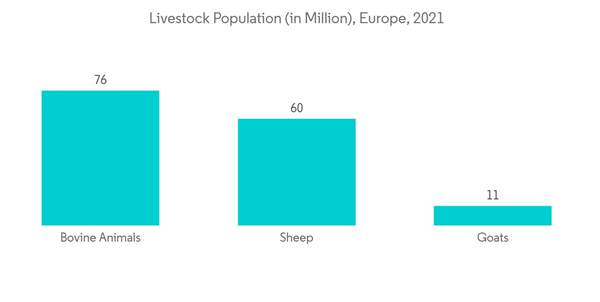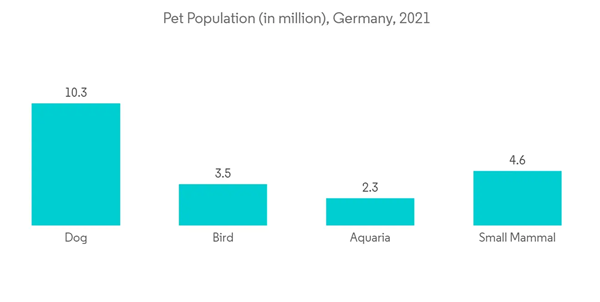The disruption in the supply chain and delays in delivering diagnostic instruments, consumables, and reagents during the European pandemic have adversely impacted the market initially during COVID-19. Some significant issues faced by the market during a pandemic include trucking bottlenecks and port checkpoints slowing down their deliveries, including critical supplies; export bans were imposed in many countries, and only a few manufacturing units were functional. Therefore, such factors impeded the market growth rate initially. On the other hand, the outbreak of the pandemic increased the ownership of pets in Spain, which positively impacted the market growth. For instance, as per the report published by the International Trade Administration in March 2021, the pet sector in Spain increased tremendously by 25.0% during the pandemic. The same report also indicated that Spain is one of Europe's top five pet markets, with 28.0 million registered pets, including 6.7 million dogs and 3.8 million cats. The data suggested that the pandemic has increased the preference of people who have integrated one or more than one pet into their homes, mostly a dog or cat. Thus, as services got impacted during the early pandemic, it also affected the growth pace of the market. However, as there is better access to veterinary healthcare services compared to the initial pandemic times and the rise in the pet population, the market is expected to regain its growth over the coming 3-4 years.
The primary factor contributing to the growth of the European veterinary healthcare market is the rising animal adoption in European countries, coupled with increasing initiatives by various governments and improved animal healthcare. According to Pet Food Manufacturers Association, as of 2021, 3.2 million households in the UK had acquired a pet since the pandemic's start. There are 34 million pets in the UK, including 12 million cats, 12 million dogs, 3.2 million small mammals like guinea pigs and hamsters, 3 million birds, and 1.5 million reptiles. Moreover, an estimated 85 million European households own at least one pet animal. The trend is further expected to enhance during the forecast period due to factors like pet humanization and the rapid adoption of pets in emerging economies. Also, as per the Pet Food Manufacturers Association report in 2021, it is estimated that 59% of households will have pets in the United Kingdom in 2021. The report also mentioned that 2% of households own rabbits, 1.2% of households own Guinea pigs, 1% of households own tortoises and turtles, 1% own horses and ponies, o.6% of households own Gerbils, and 0.8% of households own pigeons. Thus, the high percentage of households owning a companion animal is expected to drive the demand for the veterinary healthcare market.
Furthermore, government initiative plays a prime role in market growth. For instance, in August 2022, British Equine Veterinary Association (BEVA) collaborated with British Equestrian (BEF) and the British Horseracing Authority to monitor the potential impact of a shortage of doses of vaccines for Equine Influenza. BEVA is liaising with the three vaccine manufacturers to estimate the shortage's effect and propose alternatives to lessen the threat to equine health and welfare and to avoid a disruption of equestrian competition.
In addition, technological developments in animal diagnostic technologies for accurate diagnostics and the increasing penetration of some of the key and giant players in the market are expected to propel the market growth. For instance, in February 2021, IVC Evidensia launched VetSoothe to all of its UK and Netherlands clinics, an exclusive range of dermatologist-recommended and clinically proven products, including innovative skin wipes that contain chlorhexidine, an ingredient proven to inactivate Coronavirus particles that may be present on pets coats.
Therefore, the factors such as rising animal adoption in European countries, government initiatives, and technological advancements in animal diagnostic technologies are attributing to the market growth. However, the increasing costs of animal testing and veterinary services, the shortage of farm workers and veterinarians, and the use of counterfeit medicines are restraining the growth of the Europe veterinary healthcare market over the forecast period.
Europe Veterinary Healthcare Market Trends
Anti-infectives Segment is Expected to Witness High Growth Over the Forecast Period
Anti-infectives are the treatment regimen used to prevent and treat infections in animals. In Europe, a wide range of anti-infectives is being approved and commercialized by different animal healthcare companies. In addition, the rise in the prevalence of various animal diseases is expected to drive the overall growth of the market studied over the forecast period. According to a report published by Department for Environment, Food and Rural Affairs Animal and Plant Health Agency Advice Services, in November 2021, German authorities detected a fresh African swine fever outbreak in domestic pigs at a large commercial facility in the eastern state of Mecklenburg-Vorpommern. Furthermore, a German study published in September 2022 reported the incidence of diarrhea to be 18.5% and the most common disease observed in almost 14,000 neonatal calves examined on 731 German dairy herds. Additionally, according to a report published by the HM Government in September 2021, it has been observed that 45 cases of the West Nile virus were reported in Italy in September 2021. Thus, the increased prevalence of various animal diseases is expected to drive segmental growth.Also, an increase in R&D activities for developing veterinary vaccines and antiviral drugs is expected to boost the market with novel products shortly. For instance, in May 2022, the United Kingdom National Office of Animal Health (NOAH) launched the Livestock Vaccination Guideline to support vets and farmers in improving the health and welfare of United Kingdom sheep and cattle and to support farm resilience and sustainable productivity improvements. Additionally, in April 2022, Vetoquinol launched Falpreva for veterinarians in five European markets, including Italy. Falpreva is a spot-on combination for cats that treats internal and external parasite infestations/infections, including tapeworms, for up to three months in a single dose. Such development is supposed to drive market growth.
Therefore, the factors such as the rise in the prevalence of various animal diseases and increased R&D activities are expected to drive segmental growth in the market during the forecast period.
Germany is Expected to Dominate the Europe Veterinary Healthcare Market Over the Forecast Period
Germany is expected to hold a significant market share in the studied market over the forecast period owing to factors such as rising animal adoption in Germany and growing meat export. For instance, according to the FEDIAF report 2021, Germany has a total pet population of 27,000,000, of which 10,300,000 are dogs and 16,700,000 are cats. Additionally, according to Der Deutsche Heimtiermarkt, in May 2022, the number of mixed-breed dogs increased from 42% to 44%. Thus, the rising adoption of pets in Germany is expected to increase the need for veterinary healthcare which is anticipated to drive market growth. Also according to an article published by Global Agriculture Information Network, in May 2022, Germany was a leading market for pet food products with 83 million of the world's wealthiest consumers and 34.7 million pets.Product launches by the key market player are another factor in market growth. For instance, in July 2021, Boehringer Ingelheim revealed that the 2.0 version of the FreVAX smartphone app can be used to control the FreVAX intramuscular needle-free device. It was developed to improve communication with the FreVAX system, a pig intramuscular needle-free vaccine injection device. Also, in July 2022, Berlin-based startup Rex raised EUR 5 million to digitise vet care for a new generation of pet owners focusing on customer experience, digitized processes, and first-class care. The market under study is therefore anticipated to experience significant expansion throughout the forecast period as a result of the aforementioned factors.
Thus, owing to the factors such as rising animal adoption in Germany and launch of products coupled with investment in veterinary care, the studied market in Germany is expected to project growth over the forecast period.
Europe Veterinary Healthcare Industry Overview
The Europe veterinary healthcare market is fragmented in nature due to the presence of several companies operating globally as well as regionally. The competitive landscape includes an analysis of a few international as well as local companies which hold market shares and are well known, including Abaxis Inc., Bayer AG, Benfield Pet Hospital, Boehringer Ingelheim International GmbH, Ceva Animal Health Inc., CVS Group, ECO Animal Health, Elanco, Greencross Vets, Idexx Laboratories, MSD Animal Health, The Bergh Memorial Animal Hospital, Vetoquinol UK Limited, Virbac, Zoetis Animal Healthcare among others.Additional Benefits:
- The market estimate (ME) sheet in Excel format
- 3 months of analyst support
This product will be delivered within 2 business days.
Table of Contents
Companies Mentioned (Partial List)
A selection of companies mentioned in this report includes, but is not limited to:
- Boehringer Ingelheim International GmbH
- Ceva Sante Animale (CEVA)
- ECO Animal Health Group Plc
- Elanco
- Idexx Laboratories, Inc.
- MSD Animal Health
- Vetoquinol S.A.
- Virbac
- Zoetis Inc.
- Hipra
- Dopharma
- Dechra Pharmaceuticals PLC.
- Orion Corporation
- Norbrook
- Laboratorios Syva










